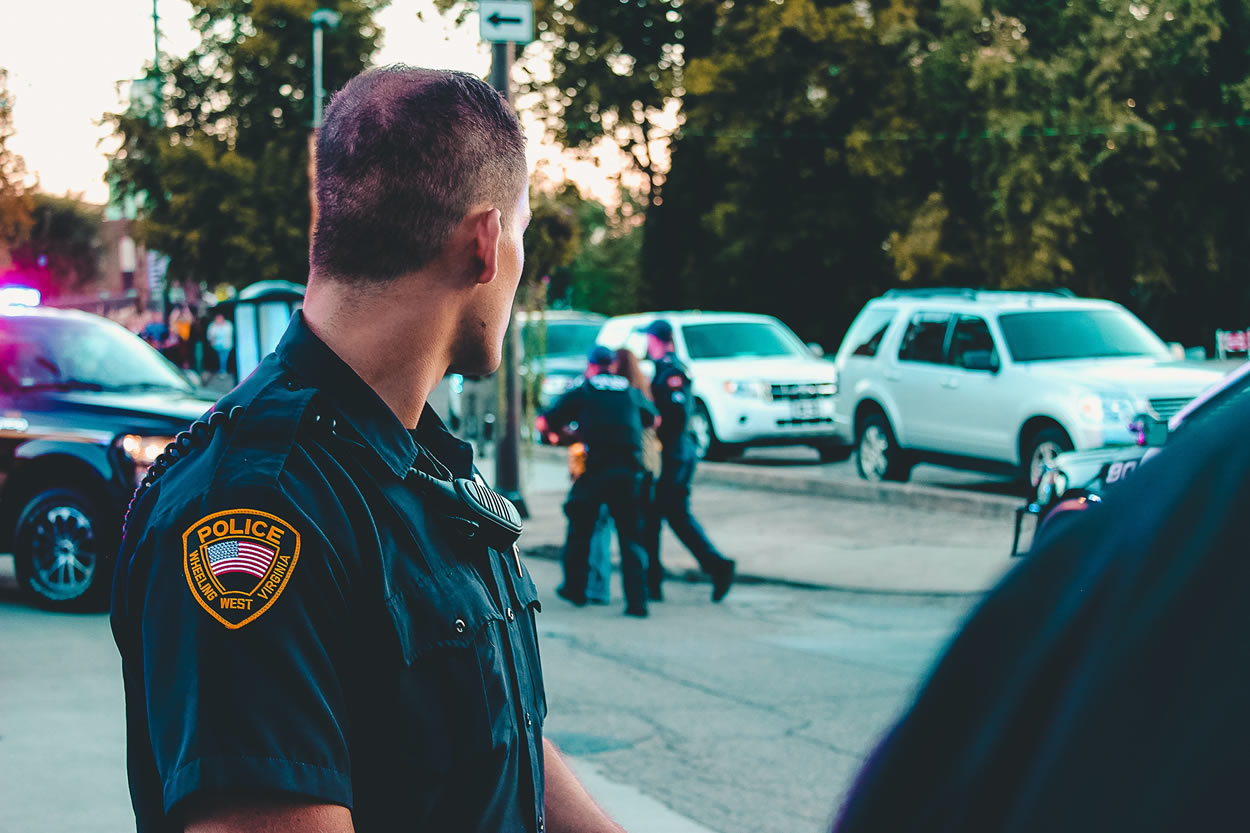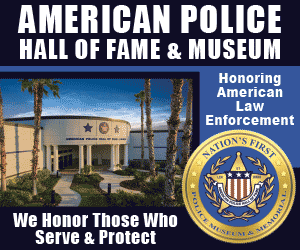Should Thou commandeth us into the
Valley of the shadow of death,
We shall fend off evil, for Thou art with us;
And our Glock comforts us.
Thou bestoist us with skills,
of unyielding integrity and
giveth the capacity that stand us all.
Our cup runneth over with gratitude (1)
Preface
You will either find the below concept to be stupid/crazy, a great idea or will generate your thinking of new ways to address the issue … or some combination of the above.
There have been articles, books — volumes — written on how to improve the morale of law enforcement — everything from psychological and public media “pep-talks” to awards to new state-of-the-art equipment. The transition from revolvers to pistols, way back in the ‘80s, to equalize firepower against the bad guys was an unmitigated boost to morale. Of course, other items such as protective vests and personal radios were great, but they had tradeoffs. Radios were heavy on the belt and you couldn’t be 2-7 without being monitored. Vests were heavy and hot. High-capacity pistols were comforting … and cool.
The age-old grade-school teaching that the “policeman” is your friend is wrong. An on-duty, uniformed LEO is not a friend in the sense that you can get in their face if you disagree with him/her or put your arm around this official of the law like you would a pal or buddy. For example, if you try to touch them without their express consent it might be deemed an assault.
On the other hand, a cop is not the enemy. LEOs are more of a trusted neighbor — a trustee of keeping peace, the representative of the representatives the voters elected to establish, and in turn, enforce the rule of law. This matter of social trust might best be addressed as education via public relations. Trust is related to morale inasmuch that if one thinks little of their employment conditions, they can’t be expected to think well of (trust) others and vice versa — such as citizens respecting LEOs and LEOs respecting citizens.
“Social trust, the faith that strangers will abide by established norms, is one of society’s most fundamental building blocks. It underlies economic growth, political consensus and effective law enforcement. When people witness better enforcement of the law — including the protection of clearly defined property rights and less manifest nepotism and favoritism at high levels of government — social trust can rise.” (2)
Morale
If nothing else, the pandemic of 2020 coupled with an unprecedented demand for police “reform” due to protests/riots related to in-custody deaths, morale among the ranks deteriorated significantly. This is not justifiable, only understandable.
Morale is the capacity of a unit’s members to maintain belief in an institution or goal, particularly in the face of opposition or hardship. Morale is often referenced by authority figures as a generic value judgment of the willpower, obedience and self-discipline of a group tasked with performing duties assigned by a superior.
“Morale is the capacity of a group of people to pull together persistently and consistently in pursuit of a common purpose.” (3) Morale is important in the military, because it improves corps cohesion. Without good morale, a force will be more likely to give up or surrender. Morale is usually assessed at a collective, rather than an individual, level.
Morale is also considered to be an important part of a fighting unit known as the esprit de corps. (The French oftentimes have words to describe feelings that are not in the English language), otherwise known as the camaraderie of battle compatriots. Unlike skills or knowledge, morale is an intangible that can’t be measured by a simple test. It improves or deteriorates with changes in conditions.
The morale of the police rank and file is paramount to effective and trustworthy guardians of society. But morale of the public, including elected officials, is equally necessary for a law-abiding proletariat and aristocracy alike. Of course, the media (including social as well and commercial sources) can and do control or sway opinion that generates morals and morale. The key to the media is in the persons and powers of various groups who influence the diverse media projectors.
Police officers are a special breed. Our secular one-size-fits-all government cannot just take anyone and make him or her a law enforcement officer with training, no matter how extensive or sensitive the training. A cop is one who first and foremost wants to be a law enforcement officer.
He or she must honestly like being in a position to help people while at the same time having a strong sense of right and wrong. He or she must exhibit ethical leadership and have a healthy fear of being labeled a coward. This is all well and good as long as the officer is able to maintain a high level of morale. Officers must feel confident in their own safety to be able to successfully protect society as well as themselves.
It would be unconscionable to expect LEOs to be equipped with nothing less than state-of-the-art, optimal tools and products in order to effectively perform their sworn duties. American politicians have done well throughout the years to provide our LEOs with high-visibility emergency lights, personal radios, vests and other products and tactics. Now might be the time to bring about a new change to not only enhance police safety and boost morale, but to better protect society.
“Police brutality means to act as an ordinary prudent person,
without a policeman’s [sic] self-discipline,
would surely act under the stresses of police work.” (4)
History
Before about the 1980s, the semi-automatic pistol was deemed unreliable, subject to malfunction, jams and inaccuracy; limited in makes and models, and anemically powered by over-penetrating ammunition — the 9mm ball cartridge (after legislatively banning dum-dum/cop-killer bullets). In addition, of the few quality semi-autos on the market, most all were single-action, requiring either the carrier to use both hands to charge the chamber or carried with a round in the chamber and the safety on. Most police agencies believed any fully cocked (hair-trigger) handgun to be a very dangerous practice as evidenced by a number of shootings when an officer’s cocked handgun accidentally discharged with lethal results.
Prior to about 2000, carrying any type of firearm open or concealed was prohibited except for LEOs. That was followed by a run of legislation and court cases that eroded this exclusivity, not the least of which was the author’s class action Ohio lawsuit (5). Almost overnight, most states commenced permitting/licensing procedures for all qualified citizens to pack heat in public.
Carrying a gun was no longer an exclusive police privilege. This generated a consciousness of anxiety as well as the lessening of police morale subconsciously. In other words, any civilian could legally carry a concealed firearm — you didn’t have to be a cop to do so. Couple this loss of uniqueness with court rulings narrowing the use of force by LEOs and expanding civilian stand-your-ground laws and morale, again, took a hit.
Due to mechanical and manufacturing improvements and to meet the demand, gun makers began producing more semi-automatic models that had a larger capacity than the tried and true 6-shot revolver. In addition, and with pressure from police and the expanding number of self-defense concealed carriers, ammunition producers created bullets with greater stopping power.
Now with the bad guys packing these high-capacity handguns loaded with more devastating bullets, it became evident that it may not be possible for LEOs to successfully survive a firefight with the tried-and-true weapon. Knowing that the criminal element was out-gunning the police, morale took an additional blow.
Well into the 1980s, and a little behind the curve, law enforcement agencies began transitioning to double/safe-action, semi-automatic pistols with up to 15-round magazines full of the same man-stopping rounds that were being used against them. Morale improved.
During a 10-year period between 2005 and 2014, 62.2 percent of officers murdered with firearms in the line of duty were shot within 0 to 10 feet of perpetrators. Of those incidents, 44.8 percent included events where offenders, within 0 to 5 feet, killed officers with firearms (6).
A counter question of, “Why do police shoot so many times?” was succinctly answered by FBI Special Agent John Huber.
“In cases when lethal use of force is justified, inflicting a single, non-fatal wound is not enough to remove the threat that person represents to the officer or others. One single shot from police is not enough when use of lethal force is legally justified. Unless an airway or certain parts of the central nervous system, such as the brain stem or upper spinal cord, are struck by a bullet, a person isn’t guaranteed to lose consciousness until they lose about 40-to-50 percent of their blood … That’s why officers are trained to fire multiple times when they are justified in doing so.” (7)
“In the 1980s and 1990s, police found themselves outgunned by criminals … We have allowed ourselves to become a country where the weapons available on the street force police officers to respond in kind to survive. Until the laws change, the police will be on the responsive end of an arms race over which they have no control. It is not the time to deprive our police officers of the equipment they need to survive on the streets.” (8)

Exclusivity
Perhaps it is time to return some amount of exceptionality — exclusiveness — to the out-gunned and demoralized street officer by issuing something only active-duty police can possess — machine-pistols (hand-held submachine guns). Hear me out. Not to disregard the reality that the bad guys/gals are currently and equally (or better) armed than we are, but they can’t pragmatically possess a fully-automatic firearm.
Machine guns are tightly registered and most difficult to obtain via legal channels — illegal channels are also difficult inasmuch that these registered weapons are few in number and held by responsible persons who keep these expensive weapons very secure. Converting semi-auto firearms to fully-automatic firearms requires the skill and expertise of a competent (also registered) gunsmith.
Allowing LEOs to carry — both on and off duty — a select-fire, fully-auto handgun would return the exclusivity factor to cops. Knowing that civilians can’t be armed with those can be a significant morale booster. How cool is that? Just the realization that their Chief would issue such an exclusive, special and restricted tool of the trade is a feel-good thing. Of course, the department would only issue machine-pistols to officers who qualify — and such qualifications would entail significant training.
Proper training is the key to
surviving attacks —
lethal as well as litigious.
Packing a concealed submachine gun capable of firing 15 9mm rounds in a very short time span is not a whole lot different — for a trained operator — than 15 shots fired in rapid succession through a semi-auto. Besides, a department rule that the submachine gun must be carried in semi-auto condition or in 3-round burst mode would negate the spray-and-pray tactic attributed to military troops under entirely different circumstances.
From this writer’s personal experience with submachine guns, they can be more accurate and safer (to the officer) than a semi-auto. With a full auto, the shooter must only visualize the target (instinctively by looking at a small point on the target or by focusing on the mechanical/optic sight) ONCE, whereas the utilization of semi-auto requires time to re-align the sight picture with each pull of the trigger. Thus, the time — albeit seconds or portions thereof — can be used to the adversary’s advantage. Moreover, rapid fire with a semi-auto, sans realigning sights, can causes misses — especially under the pressure of a shootout.
A machine-pistol with select-fire options of 3-round burst, full-auto or semi-auto would be a public relations advantage. When operated in 3-round bursts, a single pull of the trigger has a greater possibility of stopping a lethal threat before having to cease firing to access the condition of the assailant.
Heretofore, officers oftentimes just kept firing — up to a full magazine of 15 rounds before stopping to learn of the effect of their action. This many rounds generated much negative press. In addition, the chances of an errant shot are much different when 15 individual trigger pulls are utilized in emptying an entire magazine at a suspect as opposed to a maximum number of 5-trigger pulls while deploying a submachine gun in 3-shot mode before emptying an entire magazine.
Then there is the time factor. If the officer stops after each single-shot trigger pull to observe the situation and decide whether another round is needed — after reconnoitering the sight alignment — a still active-shooter will have that time to continue to inflict lethal harm on anyone, including the police who are trying to stop the perp.
Finally, there’s the deterrent factor. It’s well established that perps savor bragging rights for their battles with police. For a loser to be able to show a bullet-wound scar to fellow inmates is a status symbol. Surviving being shot by the cops is a significant morale booster to the criminal.
To put it another way, losers with nothing to lose know that today’s rapid EMT response and modern medical efficiency increases their possibility of surviving a single gunshot wound. However, a LEO utilizing a fully automatic firearm will likely mean the realization of more possible bullet holes. That equates not only to a lower chance of survival, but greater pain if the perp does not instantly perish. Thus, perps would tend to be more agreeable to capitulation than face the devastating effect of almost simultaneous multiple gunshot wounds.
Therefore, and aside from the factor of higher morale that equates to better policing, the public is better protected by trained LEOs carrying a fully automatic machine-pistol. Certainly, not all officers on a force will qualify for the honor of carrying a machine-pistol (or even want to), but the public, press and criminals won’t know which cops are so armed. Thus, that’s another deterrent dynamic.
Hardware:
Currently and available only to law enforcement agencies and the military, Glock and UZI are the only manufacturers of submachine handguns, though UZI does not offer their PRO 8 select-fire pistol in the USA at this time). The Glock 18C is similar to the Model 17, but includes an external fire-selector allowing semi-automatic to full-automatic firing modes. Presently, Heckler & Koch manufactures a short-barreled firearm with select-fire full/3-shot/semi functions, but with a telescoping stock and accessory bars that preclude concealed carry (MP7A1) (9).
Some federal agencies issue Glock 18Cs, but they are not readily available. Demand by police agencies would surely change that. Establishing a certification and testing program by police agencies should generate public and law enforcement publicity that might encourage gun makers to begin higher production of submachine gun pistol — a demand-it-and-they-will-build-it scenario.
At present there are many firearm training facilities, but few qualified to instruct in the use of submachine guns. Three that have specific submachine gun courses are:
– Tactical Defense Institute (established 1995), a Midwest facility dedicated to civilian, military and law enforcement firearms training — including submachine guns. TDI is operated by owner and CEO John Benner a longtime LEO and SWAT team originator.
– Front Sight Firearms Training Institute, a well-known operation run by founder and director Dr. Ignatius Piazza out west in the United States.
– The Georgia Public Safety Training Center is part of the Georgia Public Safety Training Center. -The NRA LE Div. offers training to those aspiring to become submachine gun trainers via their Select-Fire Instructor Course and might also have a list of submachine academies (10).
The Law
The Federal Firearms Act of 1934 requiring a registration fee of $200 with each machine gun ownership change does not apply to police agencies (11). There is no prohibition against a legitimate police agency purchasing a full-auto firearm from a legitimate maker of such firearms, then registering it under the 1934 NFA before issuing it to a member (sworn personnel as defined by law) of this agency to carry on- and/or off-duty.
But don’t just take the word of a mere writer. The author put this to the BATF in an email dated 22 Feb 2021 (copy of email message available on request). Their reply:
This may be a bit overbroad. Certainly [sic] a legitimate
State or local government agency can receive and possess registered machineguns under the NFA and under the GCA, 18 U.S.C 922(o). They can issue these to bona fide employees/LE agents of that government entity. These individual officers can possess these (possess under the authority of the government agency) in their official capacities. However, the words “off duty” require clarification.
Officers are not allowed to possess these in their personal capacities. For example, if an officer paid his/her agency $1,500 and then had a machine gun issued that they could keep and could take home, use in their personal capability at the range, it is questionable whether this is done in any “official” capacity. Stated another way, an officer cannot use his agency or his official capacity as a pretense to obtain firearms that he could not otherwise obtain in his personal capacity.
Of course, if the agency expects an officer to take firearms home while “off duty” because he/she may be called at any point in cases of emergency (or because he/she is “on duty” during the drive to and from work), this possession is within the officer’s official capacity and within the law. As an example, in one recent 6th Circuit case (12) the court considered this issue and set it out correctly as follows.
… the law prohibits private individuals from possessing a machine gun. The only persons who are lawfully authorized to possess machine guns are federal or state agents, such as police officers, acting in an official capacity at the time of possession of the machine gun …
Note though that if the officer simply used his job as an officer to obtain a personal firearm not otherwise obtainable under the law, this would not be in his official capacity.
Bottom line, the government exceptions in federal firearms law are not a means by which law enforcement officer [sic] are subject to different rules than the general public while in their private capacities.
In other words (author’s take), if an officer is departmentally required to be armed, he or she may possess (but not own) a department-owned full-auto rifle, carbine and/or handgun.
Downside
The only downside (morale-wise) to the introduction of machine-pistols might be in the inability of the heads of police agencies to convince elected officials and the media of the importance of the new weaponry. Projecting and disseminating a strong, convincing and confident stand to equip officers with unsurpassed mechanical advantages will do wonders for the safety and morale of officers and civilians alike … well, all except maybe society’s miscreants.
Pragmatically, mastering a machine-pistol requires a high level of expertise, and only a few may qualify or even want to be responsible for such a demanding weapon. For sure, there is always the possibility of errant shots from a full-auto firearm, just like there are possible errant shots from revolvers, high-capacity pistols, shotguns and “assault” type rifles. However, and regardless of the firearm used, the chances of off-target strikes during CQC conditions have always been on the low side.
Summary
There can’t be anything more demoralizing than to face a battle under-armed — and police officers are always facing a potential battle. That’s why police, universally, switched from the revolver to the high-capacity semi-auto pistol when the criminal element began packing more effective and deadly weaponry in the 1980s.
To allow the option of carrying a defensive tool that the opposition doesn’t have is not only a confidence and morale builder, but a better way to protect society by reducing the ability of an active shooter to continue shooting or at least convincing the shooter that he or she is outgunned.
Just the mere concept, fostered by the chief, is certain to improve morale. And yes, the submachine handgun theory might not be in the thinking of many of today’s law enforcement chiefs… but wasn’t the same resistance witnessed prior to the switching from revolver to the semi-auto?
For those charged with protection of society, positive LE morale is directly proportional to public and officer safety and inversely proportional to dangerous criminal activity.
Notes:
(1) Author’s rendering of a portion of the 23rd Psalm.
(2) Kevine Vallier, professor of philosophy, Bowling Green State University. Excerpted from his book, Trust in a Polarized Age, as reviewed in The Wall Street Journal, 19 Dec 2020, print edition. https://www.wsj.com/articles/why-are-americans-so-distrustful-of-each-other-11608217988
(3) Oft-quoted and accepted definition of morale: Alexander “Alec” H. Leighton, sociologist and psychiatrist. (1908-2007). https://en.wikipedia.org/wiki/Alexander_H._Leighton
(4) The New Centurions, 1970, 1st Ed., Joseph Wambaugh. Library of Congress Cat. No. 77-131254, pg. 171.
(5) Anatomy of a Constitutional Challenge To Carrying Concealed Firearms Laws (Klein vs. Leis). A comprehensive look at the political, LE, and legal reasons for and against civilian firearms possession. Though the Ohio Supreme Court ruled against an Ohio Constitutional right for civilian carrying of concealed weapons, they acknowledged the right to carry unconcealed. As a result of the arguments presented, the Ohio state legislature was persuaded to implement concealed carrying license statutes that has been referenced in law schools and other states’ concealed carry laws: https://works.bepress.com/chuck_klein/1/
(6) FBI Law Enforcement Bulletin, 13 Jul 2016, “What Is A Safe Distance?” https://leb.fbi.gov/spotlights/officer-survival-spotlight-what-is-a-safe-distance
(7) Times Picayune-New Orleans Advocate, Emily Lane, Published Mar 9, 2016 https://www.nola.com/news/crime_police/article_ae82835c-0212-5e50-a175-85601a1ed8bb.html
(8) “Civilian Firepower Put Police In Arms Race, Bernie Sullivan”, Hartford Courant, Sep 12, 2014 https://www.courant.com/opinion/op-ed/hc-op-sullivan-giving-police-more-firepower-0914-20140912-story.html
(9) UZI. https://iwi.us/uzi-pro-a-symbol-of-freedom-is-back/
Glock. https://eu.glock.com/en/products/pistols/g18
Heckler & Koch. https://www.heckler-koch.com/en/products/military/submachine-guns/mp7a1/mp7a1/overview.html
Smith & Wesson: “S&W does not manufacture a full-auto pistol or a sub-machinegun nor do we have plans to in the future.”
Colt and Sig Sauer did not reply to my query.
(10) Tactical Defense Institute: https://tdiohio.com
Front Sight Firearms Training Institute: https://www.frontsight.com/courses/uzi-submachine-gun-training-3.asp;
Georgia Public Safety Training Center: https://access.gpstc.org/student/classes/details?gpstcCode=MC1559
National Rifle Association LE Division: https://le.nra.org/law-enforcement-training/law-enforcement-schools/select-fire-instructor/
(11) The National Firearms Act of 1934 https://www.atf.gov/rules-and-regulations/national-firearms-act and as amended by Title II of the Gun Control Act (GCA) of 1968 and the 1986 Firearm Owners’ Protection Act made it illegal to own or transfer a machinegun – Exceptions were made for transfers of machine guns to, or possession of machine guns by, government agencies…. The ATF Form 5 allows for the tax-exempt transfer and registration of NFA items to government agencies, including law enforcement. A digital fillable version is available on https://www.atf.gov.
(12) United States v. Spicer, 656 F. App’x 154, 159-60 (6th Cir. 2016).





